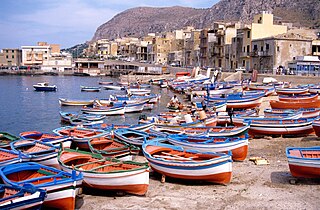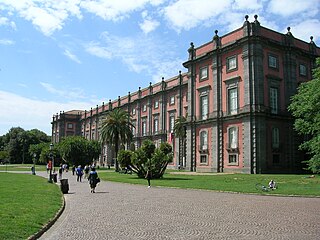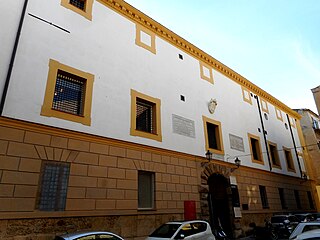This article needs additional citations for verification .(September 2023) |

The Palazzo Jung is a Neoclassical-style palace located on Via Lincoln, in front of the Orto Botanico of Palermo, in the city of Palermo, region of Sicily, Italy.
This article needs additional citations for verification .(September 2023) |

The Palazzo Jung is a Neoclassical-style palace located on Via Lincoln, in front of the Orto Botanico of Palermo, in the city of Palermo, region of Sicily, Italy.
The three-story palace was begun in the late 18th century by the family of the newly created Baron of Verbumcaudo. The building was erected on a site cleared during the destruction of the city walls and bastions in the late 18th-century. For part of the late 19th century, it was occupied by the Pensione Tersenghi. In 1921, it was purchased by the Jung, a successful family of Jewish merchants from Switzerland: the three brothers Mario, Guido, and Ugo, who started a company exporting dried fruits, citrus products, and spices. The property suffered damage from the bombardments of World War II. The descendants of the Jung family owned the property until 1958.[ citation needed ]
The property was poorly conserved, when in the late 20th century it was acquired by the provincial government and converted into the Istituto Alberghiero di Stato. The interiors have elegant neoclassical frescoes. The gardens were also rehabilitated.[ citation needed ]
One of the prominent descendants of the Jung brothers was Guido Jung (1876–1949), an avid member of the fascist party, minister of finance for Mussolini and briefly in the government of Badoglio, and coronel in the Italian army in Ethiopia. Despite having converted to Catholicism in 1935, Guido was dismissed from the army in 1939 due to Italian racial laws. [1]

Bagheria is a city and comune in the Metropolitan City of Palermo in Sicily, located approximately 10km to the east of the city centre.

The Capuchin Catacombs of Palermo are burial catacombs in Palermo, Sicily, southern Italy. Today they provide a somewhat macabre tourist attraction as well as an extraordinary historical record.

The Teatro Massimo Vittorio Emanuele is an opera house and opera company located on the Piazza Verdi in Palermo, Sicily. It was dedicated to King Victor Emanuel II. It is the biggest in Italy, and one of the largest of Europe, renowned for its perfect acoustics.

Villa del Poggio Imperiale is a predominantly neoclassical former grand ducal villa in Arcetri, just to the south of Florence in Tuscany, Central Italy. Beginning as a villa of the Baroncelli of Florence, it was seized by the Medici, became the home of a Medici princess, and a lavish retreat for a Grand Duchess with imperial pretensions. Later given to Napoleon's sister, it was reclaimed by the hereditary rulers of Tuscany before being finally converted to a prestigious girls' school. During its long history, it has often been at the centre of Italy's turbulent history, and has been rebuilt and redesigned many times.

Sicilian Baroque is the distinctive form of Baroque architecture which evolved on the island of Sicily, off the southern coast of Italy, in the 17th and 18th centuries, when it was part of the Spanish Empire. The style is recognisable not only by its typical Baroque curves and flourishes, but also by distinctive grinning masks and putti and a particular flamboyance that has given Sicily a unique architectural identity.

Museo di Capodimonte is an art museum located in the Palace of Capodimonte, a grand Bourbon palazzo in Naples, Italy designed by Giovanni Antonio Medrano. The museum is the prime repository of Neapolitan painting and decorative art, with several important works from other Italian schools of painting, and some important ancient Roman sculptures. It is one of the largest museums in Italy. The museum was inaugurated in 1957.

The Villa Spedalotto is the country home of the Paternò di Spedalotto family. The villa is situated on a hill surrounded by olive groves at Bagheria, near Palermo in Sicily. As all the Villas in Bagheria, it was built as a country house, and was traditionally used by the family only during the spring and autumn. While considered a national monument, it remains a private residence.

Palazzo Ajutamicristo is a Late-Gothic and Renaissance-style aristocratic palace located on VIa Garibaldi #23 of the ancient Kalsa quarter of Palermo, region of Sicily, Italy. It rises about a block south of Piazza Rivoluzione.

Santa Cristina is a Neoclassical-style, Roman Catholic church in Pisa, region of Tuscany, Italy. It is located on the Lungarno Gambacorti.

The Royal Palace of Capodimonte is a large palazzo in Naples, Italy. It was formerly the summer residence and hunting lodge of the Bourbon kings of the Two Sicilies, one of the two royal palaces in Naples. Today, it comprises the National Museum of Capodimonte and the Royal Forest. The palace was constructed on its somewhat cooler hilltop location just outside the city, with urban Naples ultimately expanding around it.

Palazzo Chiaramonte-Steri is a Gothic-style palace located on via Piazza Marina, facing the Giardino Garibaldi in the ancient quarter of Kalsa of Palermo, region of Sicily, Italy.

The Royal Palace of Ficuzza, also named Reggia or Real Casina di Caccia of Ficuzza is located near the town of Corleone, located some 45 kilometers from Palermo, Sicily. It was commissioned by Ferdinand IV of Naples and III of Sicily during his exile in Sicily starting after the establishment of the Parthenopean Republic in 1798.

The Palazzo Legnani Pizzardi, also known as Palazzo Pizzardi e Volta or just Palazzo Pizzardi, is a Renaissance style palace located on Via d'Azeglio #38, corner with Via Farini, in central Bologna, Italy. In 2015, the palace housed the Tribunal of Bologna.

Notarbartolo is one of the main aristocratic families of the Sicilian nobility. Originated in the Middle Ages, it gave to the island numerous personalities who have made a significant contribution to its social, political, intellectual and artistic life. The different branches of the family collected, over the centuries, numerous fiefdoms and noble titles.

The Biondo Theatre is a neoclassical and Art Nouveau-style theater building located on Via Roma #258, corner with Via Venezia, in the ancient quarter of Castellamare of central Palermo, region of Sicily, Italy. Diagonally across Via Roma is the ancient church of Sant'Antonio Abate and a stairwell descending into the warrens of the Vucciria Market.

Guido Jung was a successful Jewish-born Italian banker and merchant from Sicily.

The Palazzo Alliata di Villafranca is former aristocratic mansion, now converted into a museum, located just off Via Vittorio Emanuele facing the Piazza Bologni which opens two blocks west of the Quattro Canti intersection, in the ancient quarter of the Albergaria of the city of Palermo, region of Sicily, Italy.

The Palazzo Branciforte is Renaissance-style aristocratic palace located on Via Bara dell'Olivella, in the historic center of Palermo, region of Sicily, Italy. It underwent extensive refurbishment under the direction of the architect Gae Aulenti, and since completion of the work in 2012 has been the home of the Fondazione Sicilia, and houses a modern library, auditorium, and exhibition halls.

The Palazzo Bonocore is a Neoclassical palace located on the north side of Piazza Pretoria in central Palermo, region of Sicily, Italy.
The Palazzo Masdoni is a Baroque and Neoclassical-style palace located on Via Toschi #23 in the historic center of the town of Reggio Emilia in Italy. The palaces is notable for its quadratura or painted architecture in its two-story Sala di Musica or Music Room. From 1954 to 1991, it was the provincial office of the Italian Communist party. It rises across the street from the Istituto Omozzoli Parisetti.
38°06′47″N13°22′17″E / 38.11301°N 13.37135°E